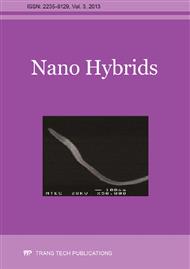[1]
N. Saifuddin, C.W. Wong, A.A. Nur Yasumira, Rapid Biosynthesis of Silver Nanoparticles Using Culture Supernatant of Bacteria with Microwave irradiation, E-Journal of Chemistry 6(1) (2009) 61-70.
DOI: 10.1155/2009/734264
Google Scholar
[2]
M. Singh, S. Singh, S. Prasada, I.S. Gambhir, Nanotechnology in medicine and antibacterial effect of silver nanoparticles, Dig. J. Nanomater. Biostruct., 3(3) (2008) 115-122.
Google Scholar
[3]
A. Pal, S. Shah, S. Devi, Preparation of silver, gold and silver-gold bimetallic nanoparticles in w/o microemulsion containing TritonX-100, Colloids Surf. A 302 (2007) 483-487.
DOI: 10.1016/j.colsurfa.2007.03.032
Google Scholar
[4]
M.J. Rosemary, T. Pradeep, Solvothermal synthesis of silver nanoparticles from Thiolates, J. Colloid Interface Sci. 268 (1) (2003) 81-84.
DOI: 10.1016/j.jcis.2003.08.009
Google Scholar
[5]
Y. Xie, R. Ye, H. Liu, Synthesis of silver nanoparticles in reverse micelles stabilized by natural biosurfactant, Colloids Surf. A 279 (2006) 175-178.
DOI: 10.1016/j.colsurfa.2005.12.056
Google Scholar
[6]
B. Soroushian, I. Lampre, J. Belloni, M. Mostafavi, Radiolysis of silver ion solutions in ethylene glycol: solvated electron and radical scavenging yields, Radiat. Phys. Chem. 72 (2005) 111-118.
DOI: 10.1016/j.radphyschem.2004.02.009
Google Scholar
[7]
J.J. Zhu, X.H. Liao, X.N. Zhao, H.Y. Hen, Preparation of silver nanorods by electrochemical methods, Mater. Lett. 49 (2001) 91-95.
Google Scholar
[8]
S. Liu, S. Chen, S. Avivi, A. Gedanken, Synthesis of amorphous silver nanoparticles by pulse sonoelectrochemical method, J. Non-Cryst. Solids 283 (1-3) (2001) 231-236.
DOI: 10.1016/s0022-3093(01)00362-3
Google Scholar
[9]
S. Pal, Y. Kyung, S. Myong, Does the Antibacterial Activity of Silver Nanoparticles Depend on the Shape of the Nanoparticle? A Study of the Gram-Negative Bacterium Escherichia coli, J. Appl. Environ. Microbiol., 73(6) (2007) 1712-1720.
DOI: 10.1128/aem.02218-06
Google Scholar
[10]
A. Panacek, L. Kvitek, R. Prucek, M. Kolar, R. Vecerova, N. Pizurova, V.K. Sharma, T. Nevecna, R. Zboril R, Initial Study on the Toxicity of Silver Nanoparticles (NPs) against Paramecium caudatum, J. Phys. Chem. B 110 (2006) 16248-16253.
DOI: 10.1021/jp808645e
Google Scholar
[11]
M.V. Roldán, A.L. Frattini, O.A. Sanctis, N.S. Pellegrini, Metal Nanoparticles with different shapes, Anales AFA 17 (2005), 212-217.
Google Scholar
[12]
Z. Zhu, L. Kai, Y. Wang, Synthesis and application of hyper branched polyesters- preparation and characterization of crystalline silver nanoparticles, Mater. Chem. Phys. 96 (2006) 447-453.
DOI: 10.1016/j.matchemphys.2005.07.067
Google Scholar
[13]
A.S. Edelstein, R.C. Cammarata (Eds. ), Nanomaterials, synthesis, Properties and applications (1996), Bristol and Philadelphia Publishers, Bristol.
Google Scholar
[14]
N. Duran, P.D. Marcato, O.L. Alves, G.I. Souza, E. Esposito, Mechanistic aspects of biosynthesis of silver nanoparticles by several Fusarium oxysporum strains, Journal of Nanobiotechnology 3 (2005) 8-14.
DOI: 10.1186/1477-3155-3-8
Google Scholar
[15]
P.T. Anstas, J. Warner, Green Chemistry: Theory and Practice, Oxford University Press, New York, NY, USA, (1998).
Google Scholar
[16]
P. Mukherjee, A. Ahmad, D. Mandal, S. Senapati, S.R. Sainkar, M.I. Khan, R. Parischa, P.V. Ajayakumar, M. Alam, R. Kumar, M. Sastry, Fungus –mediated synthesis of silver nanoparticles and their immobilization in the mycelial matrix: a novel biological approach to nanoparticle synthesis. Nano Lett. 1 (2001).
DOI: 10.1021/nl0155274
Google Scholar
[17]
M. Sastry, A. Ahmad, N.I. Islam, R. Kumar, Biosynthesis of metal nanoparticles using fungi and actinomycete, Current Sci. 85 (2003) 162-170.
Google Scholar
[18]
A. Ahmad, P. Mukherjee, S. Senapati, D. Mandal, M.I. Khan, R. Kumar, M. Sastry, Extracellular biosynthesis of silver nanoparticles using the fungus Fusarium Oxysporum, Colloids Surf. B: Biointerfaces 28 (2003) 313-318.
DOI: 10.1016/s0927-7765(02)00174-1
Google Scholar
[19]
M. Sathishkumar, K. Sneha, S.W. Won, C.W. Cho, S. Kim, Y.S. Yun, Cinnamon zeylanicum bark extract and powder mediated green synthesis of nano-crystalline silver particles and its bactericidal activity, Colloids Surf. B: Biointerfaces 73 (2009).
DOI: 10.1016/j.colsurfb.2009.06.005
Google Scholar
[20]
A. Tripathi, N. Chandrasekaran, A.M. Raichur, A. Mukherjee, Antibacterial applications of silver nanoparticles synthesized by aqueous extract of Azadirachta indica (Neem) leaves. J. Biomed. Nanotechnol. 5 (2009) 93-98.
DOI: 10.1166/jbn.2009.038
Google Scholar
[21]
T.C. Prathna, N. Chandrasekaran, A.M. Raichur, A. Mukherjee, Biomimetic synthesis of silver nanoparticles by Citrus limon (lemon) aqueous extract and theoretical prediction of particle size. Colloids Surf. B: Biointerfaces 82 (2011) 152-159.
DOI: 10.1016/j.colsurfb.2010.08.036
Google Scholar
[22]
S.K. Sivaraman, I. Elango, S. Kumar, V. Santhanam, A green protocol for room temperature synthesis of silver nanoparticles in seconds, Curr. Sci. 97 (2009) 1055-1059.
Google Scholar
[23]
J.Y. Song, B.S. Kim, Rapid biological synthesis of silver nanoparticles using plant leaf extracts. Bioprocess Biosyst. Eng. 32 (2009) 79-84.
DOI: 10.1007/s00449-008-0224-6
Google Scholar
[24]
V. K. Sharma, R.A. Yngard, Y. Lin, Silver nanoparticles: Green synthesis and their antimicrobial activities, Adv. Coll. Interf. Sci. 145 (2009) 83-96.
Google Scholar
[25]
M. Bubey, S. Bhaduria, B.S. Kushwaha, Green Synthesis of Nanosilver Particles from Extract of Eucalyptus Hybrida (Safeda) Leaf, Dig. J. Nanomater. Biostruct. 4(3) (2009) 537-543.
Google Scholar
[26]
E. Parameswari, C. Udayasoorian, S.P. Sebastian, R.M. Jayabalakrishnan, The bactericidal potential of silver nanoparticles, International Research Journal of Biotechnology 1(3) (2010) 44-49.
Google Scholar


